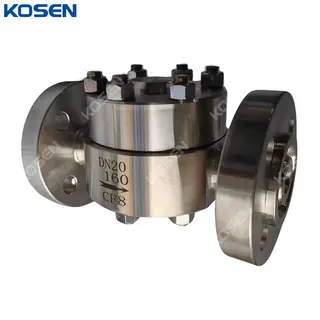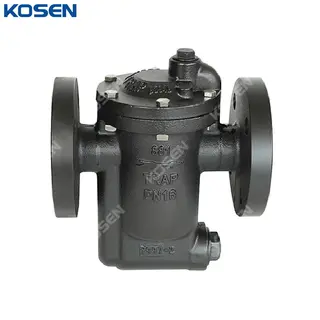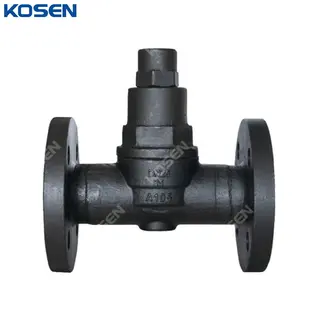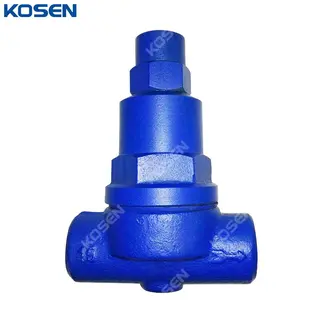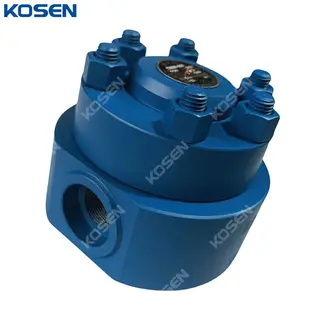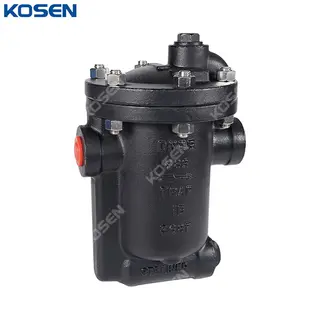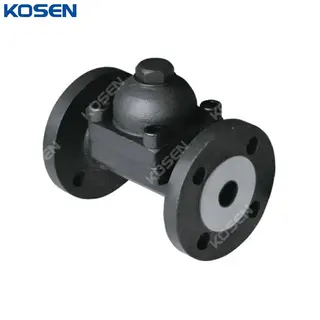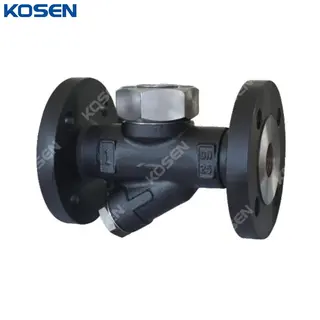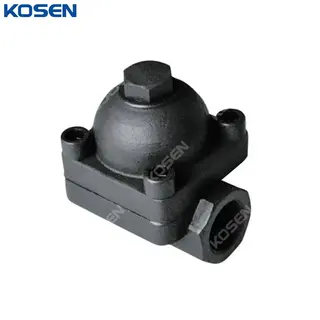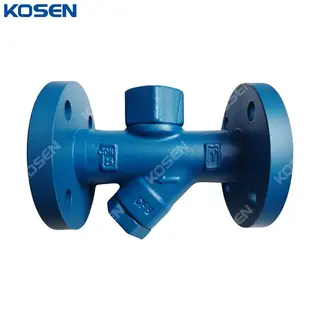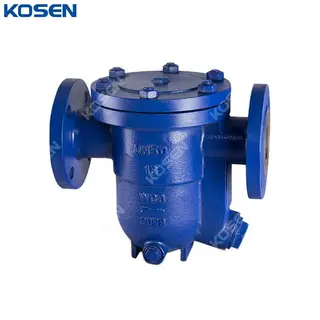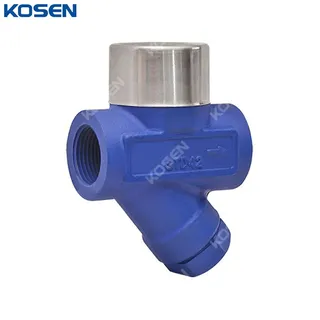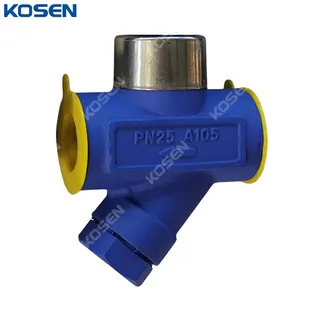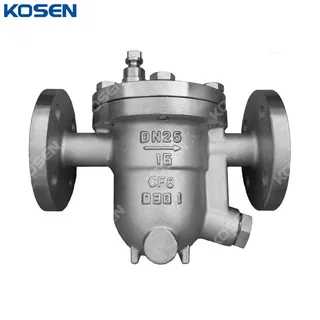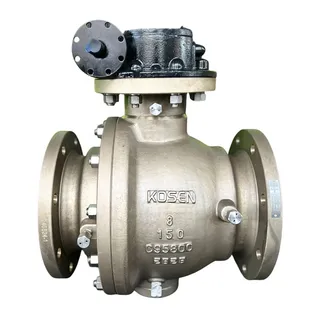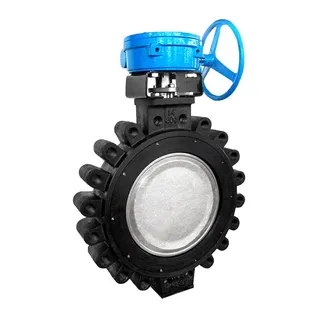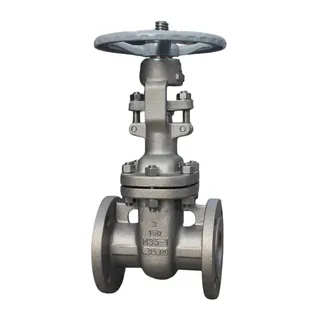The working principle of a steam trap is based on the density difference between steam and condensate, along with the buoyancy effect. It primarily operates by automatically opening and closing the valve to discharge condensate while preventing steam leakage. The working process can be divided into several key stages.
Entry and Accumulation of Condensate: The steam trap is typically installed between steam heating equipment and the condensate return manifold. When condensate enters the steam trap, it flows to the bottom of the trap, filling the valve body, and is discharged through the valve to the return manifold.
Entry of Steam and Buoyancy Effect: At the same time, steam enters the valve body from the bottom of the trap and occupies the top of the trap, creating buoyancy. As condensate continues to accumulate, the water level in the trap gradually rises, increasing the resulting pull.
Valve Opening: As the condensate continues to fill, the water level rises to a certain point, and the pull becomes sufficient to overcome the valve's differential pressure, causing the valve to open and discharge the condensate.
Valve Closure and Prevention of Steam Leakage: When the steam trap closes, the differential pressure across the valve increases, and the trap begins to rise, gradually pushing the lever towards the valve seat until the valve is fully closed, effectively preventing steam leakage.
Air and Gas Discharge and Circulation: During operation, air and carbon dioxide gas accumulate at the top of the steam trap through vent holes. The discharged steam condenses due to heat dissipation, forming a new working cycle.
Steam traps can be categorized into three main types based on their working principles: mechanical, thermodynamic, and thermostatic. Each type has its unique operating mechanism and application characteristics.
Mechanical steam traps utilize the density difference between steam and condensate to function. They are sensitive to the liquid level and open or close the valve according to the changes in condensate levels. Common types of mechanical steam traps include bucket type, bellows type, float type, and disc type. The condensate discharged by these traps is almost the same pressure as the steam, classified as saturated water, and can be used to generate secondary steam. These traps are suitable for systems with higher steam pressure requirements.
Thermodynamic steam traps rely on the temperature difference between steam and condensate, using temperature-sensitive elements to control valve opening and closing through expansion and deformation. Common temperature-sensitive elements include bimetallic strips and bellows, which change shape with temperature changes, adjusting the trap's operation. These traps are suitable for conditions with significant temperature variations, and the discharged water temperature is typically lower than the saturated temperature, thus unable to discharge saturated water. However, they have excellent air-discharge performance. Typical thermodynamic steam traps include bimetallic strip types, bellows types, diaphragm types, and membrane types.
Thermostatic steam traps operate based on the pressure differential created by differences in steam and condensate flow rates. When condensate flows to the lower pressure area, secondary evaporation occurs, driving the valve mechanism. These traps often include a pressure-buffering chamber, where the pressure changes when condensate flows in or cools, triggering the valve opening or closing. Common thermodynamic steam traps include orifice, pulse, and disc types. Thermostatic traps are compact, lightweight, and have a large pressure range, excellent water hammer resistance, fast operation, and are less prone to freezing. Although they may experience slight steam leakage, their ease of maintenance and stable operation make them widely used in systems requiring quick response and water hammer resistance.
Steam traps play an essential role in steam systems, with the following main functions.
Ensuring Efficient Heating and Energy Saving: The primary function of a steam trap is to quickly discharge the condensate produced in steam equipment, maintaining the equipment's efficient heating state. By effectively removing condensate, the steam trap ensures that the steam space inside the equipment is not occupied by water, thereby maintaining heating efficiency. If the steam trap fails to work properly, condensate buildup can impair steam equipment performance or even cause complete failure. Therefore, the proper operation of the steam trap is crucial for keeping steam equipment in optimal condition.
Reducing Preheat Time and Increasing Production Efficiency: When equipment starts up, the steam pipelines and equipment are usually filled with air and low-temperature condensate. Without timely removal of these substances, steam cannot smoothly enter the equipment, leading to prolonged preheating times. The steam trap can quickly discharge initial air and low-temperature condensate, speeding up the heating process, shortening preheat time, and ensuring that equipment reaches normal operation in a shorter period. This is particularly important for intermittent production, as it significantly reduces startup time, increases production cycles, and thus improves overall output. Moreover, the steam trap's automatic discharge function also reduces manual operation, enhancing work efficiency.
Reducing Steam Leakage and Lowering Energy Consumption: Another crucial function of the steam trap is to reduce its own steam consumption. Steam traps experience slight steam leakage during operation, which includes the steam required for valve operation and losses due to heat dissipation. By selecting and maintaining steam traps properly, this steam loss can be minimized, further improving the system's energy efficiency and economy.
When selecting a steam trap, multiple factors must be considered to ensure efficient operation under actual working conditions. Here are the key elements that must be taken into account during the selection process:
Maximum Condensate Flow: During selection, the maximum condensate flow is determined by multiplying the equipment's hourly steam consumption by a factor of 2-3 times. This ensures that the steam trap can rapidly expel a large amount of condensate when the system starts up, helping the heating equipment reach its operating temperature quickly. If the drainage capacity is insufficient, condensate will not be expelled in a timely manner, reducing the thermal efficiency of the heating equipment.
Drainage Requirements During Startup: When starting up, the system is filled with air and generates a significant amount of low-temperature condensate, which the steam trap must expel. Since the pressure during startup is lower, the drainage requirements are higher than during normal operation. A selection factor of 2-3 times ensures the steam trap can handle the overload, allowing the equipment to heat up quickly and reach normal operating conditions.
Working Pressure Differential: The nominal pressure alone should not be relied upon when selecting a steam trap, as it only indicates the pressure resistance of the trap body and does not accurately reflect operating conditions. The correct choice should be based on the working pressure differential, which is the difference between the pressure before the steam trap and the back pressure at the outlet.
Back Pressure Calculation: The size of the back pressure after the steam trap directly affects its drainage performance. If the condensate is discharged directly to the atmosphere, the back pressure is zero. If condensate is collected for recycling, the back pressure will be the sum of the resistance in the return pipe, the elevation of the return pipe, and the pressure inside the return tank. When designing and selecting, the characteristics of the return water system must be considered to accurately assess the impact of back pressure on the steam trap's performance.
Steam Temperature Requirements: When selecting a steam trap, the highest temperature in the pipeline should be taken into account. If the steam temperature exceeds the saturated steam temperature corresponding to the nominal pressure, it is superheated steam. In this case, a high-temperature, high-pressure steam trap designed for superheated steam should be chosen. These traps can withstand high temperatures and pressures and effectively expel condensate from superheated steam, preventing steam leakage or system damage.
Process Requirements: When selecting a steam trap, it is essential to ensure that it meets the process conditions of the system. The selection should not only consider the steam system's pressure and temperature but also evaluate factors such as load fluctuations, usage frequency, and operational time. Selecting the appropriate steam trap can significantly improve the system's thermal efficiency and energy-saving performance.
Matching with Equipment and Piping: The specific characteristics of each piece of equipment and piping, such as maximum steam flow, drainage requirements, and system load changes, will influence the choice of steam trap. The steam trap should be precisely selected according to the system's operating conditions to ensure stable performance throughout its lifecycle.
Following correct installation procedures and details is crucial to ensure the efficient and long-term operation of a steam trap. The main considerations and recommendations for the installation process are as follows.
Pipeline Cleaning: Before installing the steam trap, the pipeline should be flushed with pressurized steam to thoroughly remove any debris and dirt, preventing clogging of the trap.
Filter Installation: A filter should be installed before the steam trap to prevent clogging from pipeline debris. The filter should be regularly inspected and cleaned to ensure the normal operation of the trap.
Valve Installation: Valves should be installed both before and after the steam trap to facilitate maintenance and inspection. This allows the steam trap to be quickly shut off when necessary, preventing system disruption.
Condensate Flow Direction: During installation, ensure that the flow direction of the steam trap aligns with the arrow indicated on the trap. Incorrect installation may impact its normal function.
Installation Position: The steam trap should be installed at the lowest point of the equipment outlet to ensure condensate is discharged promptly and to avoid steam resistance in the pipe. If there is no space at the lowest point of the equipment, a condensate lift joint or anti-siphon loop should be installed at the lowest outlet position to lift the condensate level before installing the trap.
Avoiding Submersion: The outlet pipe of the steam trap should not be submerged in water, as this may cause steam backflow and reduce equipment efficiency.
Mechanical Steam Trap Installation: Mechanical steam traps should be installed horizontally to ensure proper function.
Avoiding Series Installation: Steam traps should not be installed in series. Each piece of equipment should have its own independent steam trap to ensure that each device's drainage needs are met.
Thermodynamic Steam Trap: For thermodynamic steam traps, a non-insulated cooling pipe of more than one meter is required before the trap to ensure effective operation. Other types of steam traps should be installed as close as possible to the equipment.
Maintenance of Steam Traps
Maintaining steam traps is key to ensuring their long-term reliable operation. Proper maintenance extends the lifespan of the trap and reduces the likelihood of malfunctions.
Regular Inspections: Regular inspections are the foundation of steam trap maintenance. The goal is to identify potential issues early. During the inspection, check the steam trap's operation to ensure it opens and closes normally. Also, inspect surrounding pipelines for leaks or signs of corrosion, and repair them promptly to prevent further damage.
Cleaning Steam Traps: Steam traps can accumulate debris (such as rust, sediments, etc.) due to the water quality in the pipeline and the process conditions. These impurities can affect the normal operation of the trap or even cause blockages. Therefore, regular cleaning is necessary. Use appropriate cleaning agents and tools to thoroughly remove internal debris, ensuring smooth operation.
Sealing Performance Check: The sealing performance of the steam trap directly affects its efficiency and lifespan. Leaks not only waste energy but can also disrupt the system. Regularly checking the trap's sealing performance and replacing the sealing components when necessary is an important part of maintenance.
Adjusting the Steam Trap: Adjusting the steam trap helps ensure its stability and accuracy during operation. The opening and closing pressures should be set according to actual conditions to ensure the trap effectively expels condensate and other impurities, preventing system problems.
Regular Servicing: Regular servicing is an essential part of maintenance. During servicing, the steam trap can be lubricated and treated to prevent rust, maintaining its proper working condition. Regular servicing can significantly extend the trap's lifespan and reduce the likelihood of malfunctions.
Steam traps are critical fluid control devices that are widely used across various industries to remove condensate from systems and ensure efficient operation of equipment and systems.
Steam Systems: In steam systems, steam traps are used to expel condensate from steam pipelines, preventing water hammer and ensuring safe and efficient operation.
Heating Systems: In heating systems, steam traps expel condensate from heating equipment, ensuring optimal heating performance and maintaining system stability.
Cooling Systems: In cooling systems, steam traps discharge condensate to prevent blockages and corrosion in pipelines, ensuring effective cooling and long-term stable operation.
Air Conditioning Systems: Steam traps expel condensate from air conditioning systems to prevent any negative impact on equipment and ensure smooth operation, improving cooling efficiency.
Petrochemical Industry: In the petrochemical industry, steam traps remove condensate and non-condensable gases from the process flow, maintaining process stability, preventing equipment damage, and ensuring production safety.
Food and Beverage Processing: In the food and beverage industry, steam traps ensure efficient heat exchange in production lines, preventing temperature fluctuations from affecting product quality.
Pharmaceutical Industry: In pharmaceutical manufacturing, steam traps maintain the stability of clean steam and condensate systems, preventing contamination and ensuring the quality of drug production while maintaining environmental stability.
